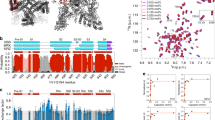Abstract
Slow recovery from desensitization of P2X3 receptors makes quite problematical understanding of their physiological function. We found that the recovery from desensitization of P2X3 receptors is speeded up by a decrease in external pH and an increase in temperature. On the contrary, the onset of desensitization is independent of these influences. Such unusual combination of temperature sensitivity/insensitivity allows receptors to function near normal body temperature even at low nanomolar concentrations of ATP. Since it is known that slight acidosis and increased temperature are typical of inflammation, we conclude that under inflammatory conditions the function of P2X3 receptors is upregulated.
Similar content being viewed by others
References
L. Vulchanova, M. S. Riedl, S. J. Shuster, et al., “P2X3 is expressed by DRG neurons that terminate in inner lamina II,” Eur. J. Neurosci., 10, 3470–3478 (1998).
D. A. Cockayne, S. G. Hamilton, Q. M. Zhu, et al., “Urinary bladder hyporeflexia and reduced pain-related behavior in P2X3-deficient mice,” Nature, 407, 1011–1015 (2000).
V. Souslova, P. Cesare, Y. Ding, et al., “Warm-coding deficits and aberrant inflammatory pain in mice lacking P2X3 receptors,” Nature, 407, 1015–1017 (2000).
I. Shimizu, T. Iida, Y. Guan, et al., “Enhanced thermal avoidance in mice lacking the ATP receptor P2X3,” Pain, 116, 96–108 (2005).
E. B. Pratt, T. S. Brink, P. Bergson, et al., “Use-dependent inhibition of P2X3 receptors by nanomolar agonist,” J. Neurosci., 25, 7359–7365 (2005).
J. Li, N. C. King, and L. I. Sinoway, “ATP concentrations and muscle tension increase linearly with muscle contraction,” J. Appl. Physiol., 95, 577–583 (2003).
G. Vassort, “Adenosine 5′-triphosphate: a P2-purinergic agonist in the myocardium,” Physiol. Rev., 81, 767–806 (2001).
D. Hille, Ion Channels of Excitable Membranes, Sinauer Associates, Inc., Sunderland, Mass. (2001).
T. Youn, S. A. Kim, and C. M. Hai, “Length-dependent modulation of smooth muscle activation: effects of agonist, cytochalasin, and temperature,” Am. J. Physiol., 274, C1601–C1607 (1998).
Y. Tsuchiya, M. Akashi, and E. Nishida, “Temperature compensation and temperature resetting of circadian rhythms in mammalian cultured fibroblasts,” Genes Cells, 8, 713–720 (2003).
Author information
Authors and Affiliations
Corresponding author
Additional information
Neirofiziologiya/Neurophysiology, Vol. 39, Nos. 4/5, pp. 377–379, July–October, 2007.
Rights and permissions
About this article
Cite this article
Maximyuk, O., Khmyz, V. & Krishtal, O. Increased temperature and acidosis effectively accelerate the recovery of P2X3 receptors from desensitization. Neurophysiology 39, 330–331 (2007). https://doi.org/10.1007/s11062-007-0046-1
Issue Date:
DOI: https://doi.org/10.1007/s11062-007-0046-1



